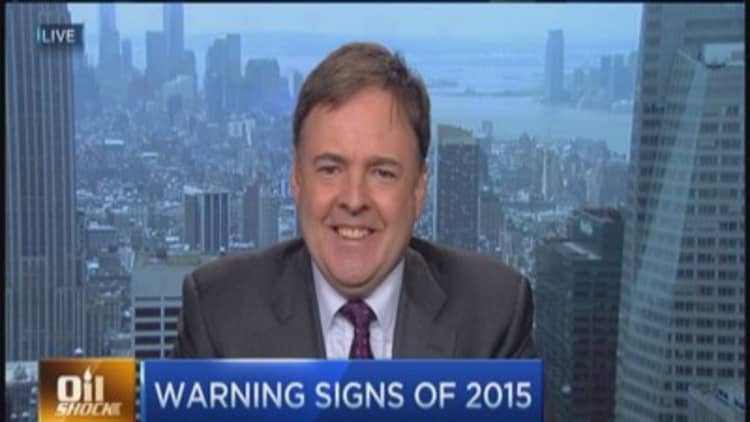
These aren't predictions; they're more like contingencies. Playbooks, if you will, for possible outcomes; keys to the coming year. May it be a prosperous one.
The yield curve.
Think we're finally heading into a "rising rate environment?" Better think about exactly what that is. Sure, short-term interest rates are moving up. But the rate on longer-dated bonds isn't budging—and that's the rate that matters most to pension funds, insurance firms, mortgage lenders and other financial players.
What if the interest rate on benchmark 10- and 30-year Treasurys doesn't increase next year, even as the rate on one-year Treasury notes rises? What if that so-called "yield curve" keeps flattening? That's the bet Jeremy Hill, managing partner at Old Blackheath Cos. is making. He sees the one-year Treasury yield above 1 percent next year but the 10-year yield hovering below 2.5 percent.
Read MoreSantelli Exchange: Flattening yield curve
We've seen this before, during just the last expansion, when then-Federal Reserve chief Alan Greenspan dubbed it a "conundrum," because traditionally, a flat or inverted yield curve was seen as a harbinger of a downturn. Economists today are still debating whether the inversion in 2006 was a useful sign of the looming sharp recession—and whether such an event now would be similarly worrisome.
Again, the point here is that a "rising rate environment" is not a uniform thing. And investors betting on higher rates better be clear about which rates—and which connected investments—they're counting on.
Oil patch layoffs
Whether the oil price collapse triggers a broader U.S. slowdown next year will be evidenced in part by one incredibly useful weekly data point: jobless claims.
The Labor Department tracks new claims for unemployment benefits, and this data series has long been a favorite of investors. Michael Darda, chief economist of MKM Partners, notes that there's almost always been a 20 percent year-on-year spike in claim filings as the economy has fallen into recession. Watching this series has helped him avoid many of the market-crash calls his colleagues have made in recent years; claims have been steadily improving, lately hovering at 14-year lows.
Read MoreSaudi Arabia doesn't care about volatile oil
Helpfully, claims are tracked at both a national and state level. Some increase seems inevitable now in states like North Dakota and Texas whose economies have boomed along with oil. The question for investors is by how much. So long as workers let go from oil and gas industries can find new work elsewhere in a relatively quick period, both the local and national economies ought to perform reasonably well. If instead there is a surge in layoffs that pushes claims at the state and even national level well above year-ago levels, then investors may well have to flip to their slowdown plays.
Millennials
What's the common link between the rental boom, weak bank loan growth, and the underperformance of General Mills and Campbell Soup? The characteristics of the millennial generation certainly play a part. This group in terms of sheer numbers is now the largest age cohort in America, and finally of an age and an economic situation to exercise their vast influence across the U.S. economy.
The new year could be a key inflection for millennials, said Bill Smead, founder of Smead Capital Management. He sees this group finally having babies, choosing to buy homes rather than rent, purchasing cars, and perhaps even cooking more at home after years of delivery and eating on the go. The investment implications here are obvious. Should millennials instead take another couple of years to make this transition—or never quite make it at all, for various reasons—it points to a very different outcome for everything from the car-service upstart Uber to home builders to traditional banks.
Read MoreMillennials will make 'rent bubble' disappear: Pro
Trying to pick some consumer names for next year's investment list? First, talk to a 24-year-old.
The stock market's multiple
There's one quite useful way to determine if the stock market rally is running out of steam. Namely: Are stocks rising because corporate profits (and future cash flows) are, or are they rising for other reasons? If there's one concern that's starting to be expressed across Wall Street, it's the generally shared enthusiasm for U.S. equities worldwide. Even last year, Bill Miller, chairman of LMM, and others were warning about a "melt-up." That could still happen if everyone piles out of other investments for various reasons (commodities, emerging markets and bonds come to mind) and into the U.S. stock market.
And that makes earnings season critically important. Yes, the precise tallies by different firms can be all over the map. It's useful to consult more than one for that reason. But generally speaking, so long as earnings are still growing at a healthy year-on-year clip (even as, say, energy-sector earnings collapse), the stock market's rally should still be considered a "healthy" one. There are always caveats: Lately, corporate buybacks and other types of so-called "financial engineering" are top ones.
Read MoreThe 100% Club: These stocks doubled this year
That makes not just earnings-per-share measures, but also total corporate profit numbers economy-wide important to watch. The Labor Department, fortunately, does provide this data. It's a bit slow, released about a month after most companies report earnings results, but worth following closely next year.
And investors won't be the only ones paying heed: The Federal Reserve is placing ever-more emphasis itself on these gauges of the financial system. An overvalued stock market relative to earnings is more likely to lead to rate hikes than an undervalued one. The multiple matters.


